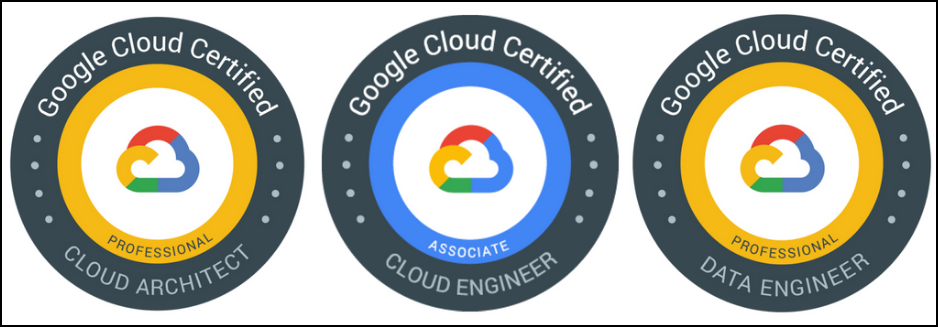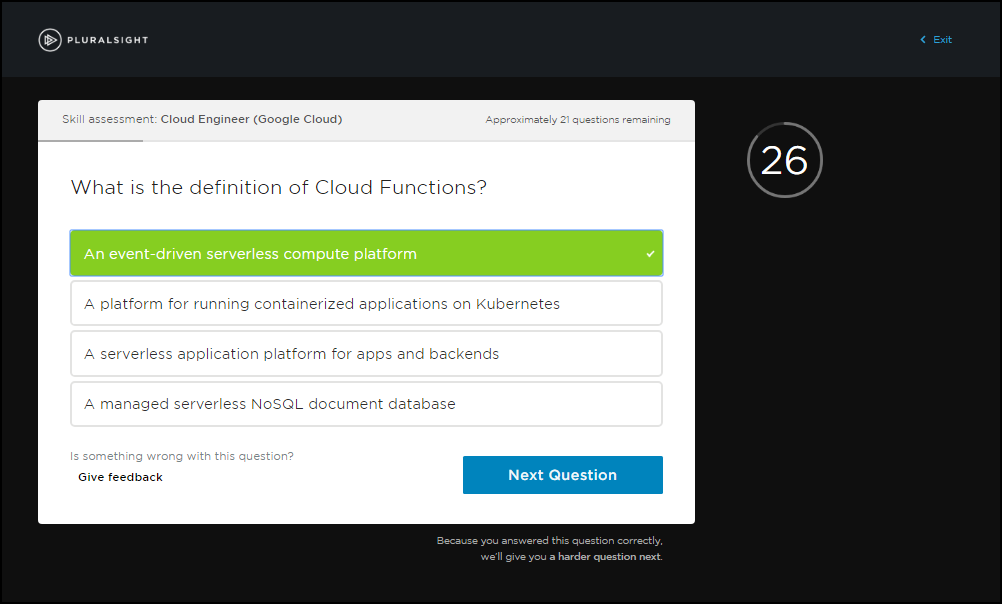A Brief Introduction to Google Cloud (GC) Certifications
Jul 13, 2020 • 13 Minute Read
Introduction
To call Google an information technology (IT) industry titan is an understatement. Statcounter gives Google Chrome a 63% browser market share and 92% search engine market share worldwide as of April 2020.
This guide is currently being written in Google Docs, part of the Google G Suite productivity app family.
What's cool about Google is that they share their own inventions. For example, Google developed a file system and big data analytics platform to help them index the world wide web and then released these technologies to the world. If you're familiar with the big data analytics world you've probably heard of Hadoop and MapReduce.
Oh, and we can't forget about Google's pioneering work with Docker container orchestration. You ever hear of Kubernetes? Yeah, that was originally a Google invention as well.
Gartner lists Google Cloud (GC) as one of the "big three" public cloud computing vendors, alongside Microsoft Azure and Amazon Web Services (AWS).
This last point brings us to the purpose of this guide. You may want to earn one or more Google certifications to demonstrate your competency with the Google Cloud. At whom does Google aim their GC certification? What are the prerequisites? Read on--we'll answer all your questions.
General Program Attributes
The Google Cloud certifications are role-based and consist of three tiers. Google aims the Associate certifications at IT professionals who deploy, monitor, and maintain Google Cloud-based projects.
The Professional certifications deal with advanced Google Cloud design, implementation, and management skills.
Google aims its User certifications at G Suite end users. This guide won’t cover Google User certification, but you can learn more about it in the Google Cloud documentation.
The GC Associate and Professional certification all share the same basic attributes:
- Each certification requires that you pass a single computer-based exam
- There are no prerequisites, either in terms of industry experience or required attendance of a training course
- The registration fee averages $125−$200 per attempt
- You can take the exams from your home or office via Webassessor
- The exam consists only of multiple choice items (no performance-based labs)
- The typical exam duration is two hours
- The certifications are valid for two years. Read the FAQ to find out more about Google's recertification policies
Like many IT certification vendors, Google issues verifiable and shareable badges you can use to prove you hold the credential.
The compensation and employment outlook for Google Cloud certifications is quite good indeed. Check out the following salary survey data:
- CIODive: Google Certified Professional Cloud Architect ranked #1 in highest-paying certifications of 2019 at $139,529
- Global Knowledge: Google Certified Professional Cloud Architect ranked #1 at $175,761
- Glassdoor: Lists Google cloud architects as experiencing a "hiring surge" as of April 2020; salaries range from $149,000 to $179,000 annually on average
Next, this guide will survey the GC Associate and Professional certification portfolios.
Associate Certification
Although there are no formal prerequisites to the GC certifications, Google recommends that you've amassed at least six months of Google Cloud experience before going for your Associate Cloud Engineer (ACE) credential.
To earn your ACE, you must pass the Associate Cloud Engineer exam. This exam assesses your ability to:
- Plan a cloud solution environment
- Deploy and configure a cloud solution
- Ensure the cloud solution's successful operation
- Configure access and security
Professional Certification
Google offers only one Associate certification, but they offer a whopping seven Professional certifications to choose from. Recommended industry experience for them is three years, with at least one year on Google Cloud.
Remember, each role-based certification requires only one exam; these links will take you to the exams' landing pages and exam guides:
- Professional Cloud Architect (exam guide)
- Professional Cloud Developer (exam guide)
- Professional Data Engineer (exam guide)
- Professional Cloud DevOps Engineer (exam guide)
- Professional Cloud Security Engineer (exam guide)
- Professional Cloud Network Engineer (exam guide)
- Professional Collaboration Engineer (exam guide)
If you've seen the Microsoft Azure or AWS role-based certifications, you will see similarities in job role definitions across the "big three" cloud vendors.
In what order should I complete these certifications?
None of the Google Cloud certifications has any dependencies or formal prerequisites. Therefore, you should focus on the GC credential(s) that most closely align with your professional interest and aptitude.
What Pluralsight content teaches me what I need to know for these certifications?
Good question! Pluralsight hosts Google's own official training in our library, so you can leverage your existing Pluralsight subscription to learn Google Cloud skills directly from the source!
Pluralsight published 13 skill paths that cover the aforementioned GC job roles. Those paths are:
- Advanced Machine Learning on Google Cloud
- Machine Learning on Google Cloud
- Security in Google Cloud
- Data Engineering on Google Cloud
- Networking in Google Cloud
- Google Cloud Big Data - Foundations
- Google Cloud Business Essentials
- Data Analytics on Google Cloud
- Developing Applications with Google Cloud
- Architecting with Google Compute Engine
- Architecting Hybrid Cloud Infrastructure with Anthos
- Architecting with Google Kubernetes Engine
- Architecting with Google Cloud - Foundations
You should craft a study plan that aligns the previous Pluralsight paths with the content domains in your chosen GC certification exam.
Pluralsight's Role IQ quantifies your technical proficiency in a specific job role. A role consists of one or more courses; some of these courses have associated Skill IQs that measure your knowledge of a certain technology.
As of this writing in May 2020 Pluralsight has two GC-aligned Role IQs, each with three associated Skill IQs:
-
Skill IQ: Performing Foundational Tasks in Google Cloud Platform
-
Skill IQ: Building Google Cloud Platform Infrastructures on GKE
-
Skill IQ: Building Google Cloud Platform Infrastructures on Google Compute Engine
In fact, Figure 2 shows you a representative assessment question from our Google Cloud Engineer Skill IQ.
What practice exams exist?
Google created practice exams for each certification; these are free and accessible directly in a web browser:
- Associate Cloud Engineer practice exam
- Professional Cloud Architect practice exam
- Professional Cloud Developer practice exam
- Professional Data Engineer practice exam
- Professional Cloud DevOps Engineer practice exam
- Professional Cloud Security Engineer practice exam
- Professional Cloud Network Engineer practice exam
- Professional Collaboration Engineer practice exam
With respect to gaining hands-on product practice, you have a few options. You should register a GC account and use their free usage tier if you haven't already done so. You get $300 in free credit immediately, and some services have an "always free" tier.
QuikLabs has a large variety of Google Cloud hands-on labs. Note that these exercises are not simulations, but allow you to work in the real, live Google Cloud environment.
Conclusion
Well, there you have it! You now possess an excellent general understanding of the Google Cloud certification portfolio. You also have Pluralsight and non-Pluralsight resources to help you gain the necessary theoretical, practical, and practice experience required to conquer those exams and earn your GC badges. All the best to you in your Google cloud certification journey!
Advance your tech skills today
Access courses on AI, cloud, data, security, and more—all led by industry experts.





